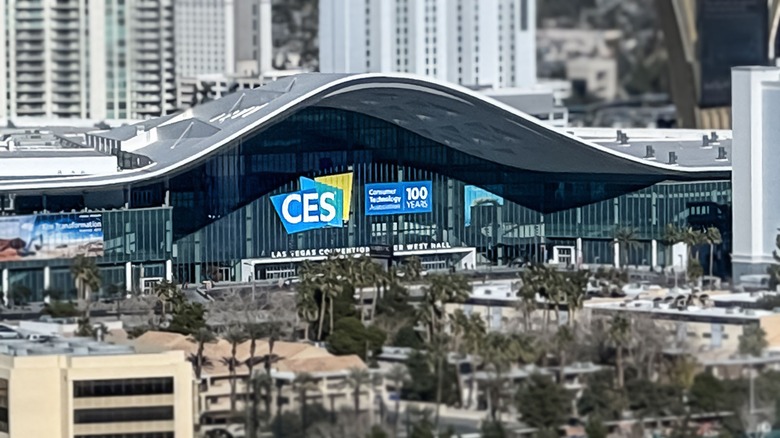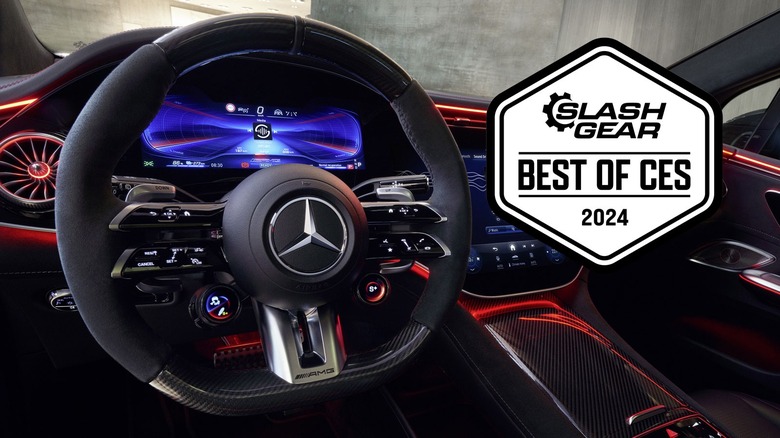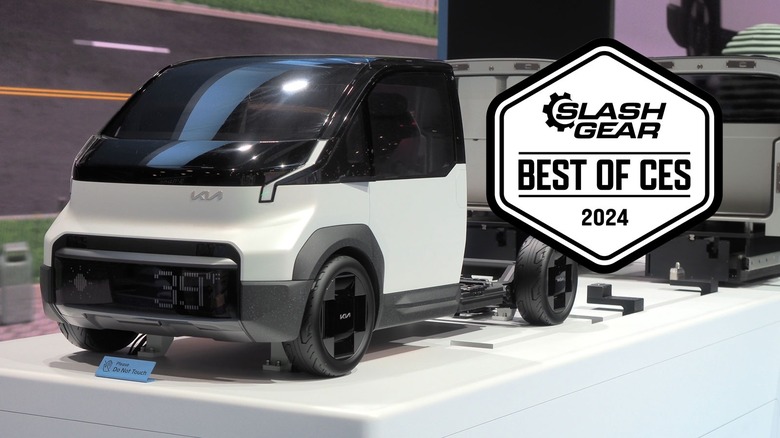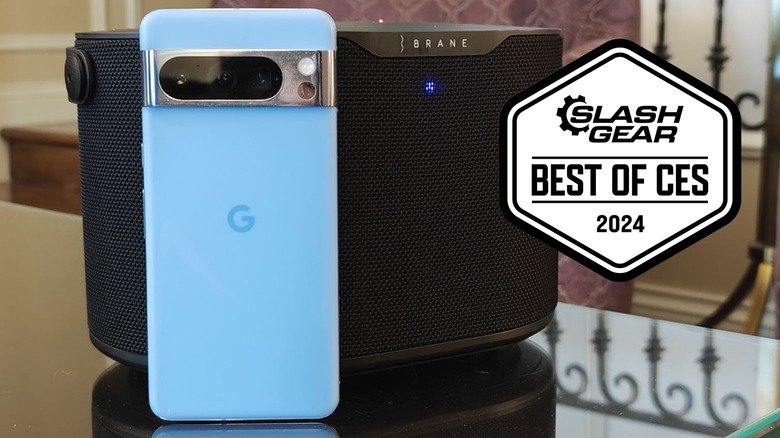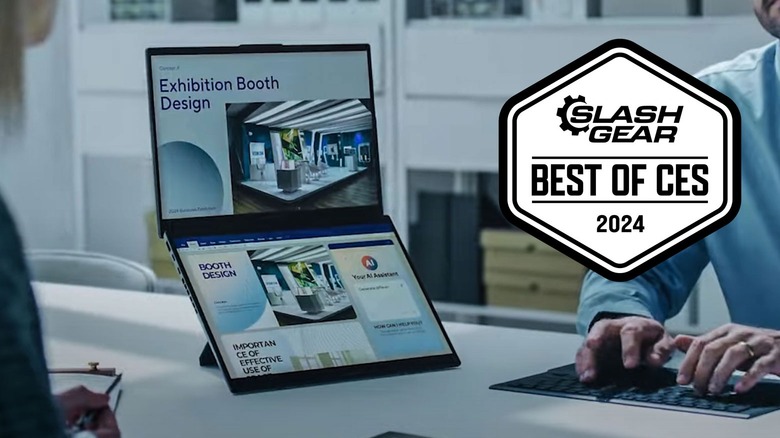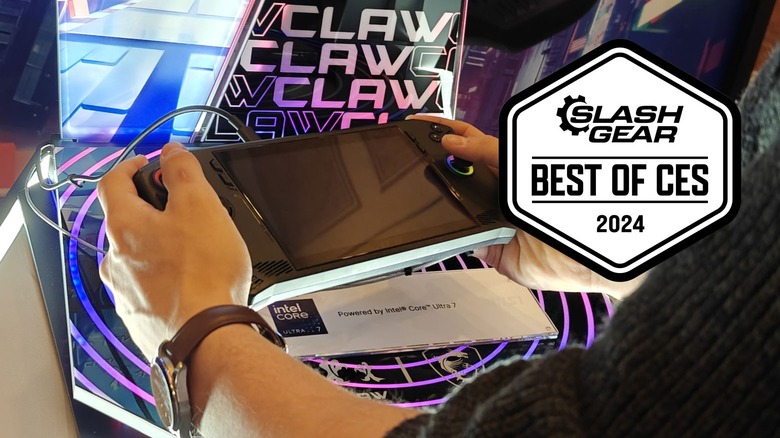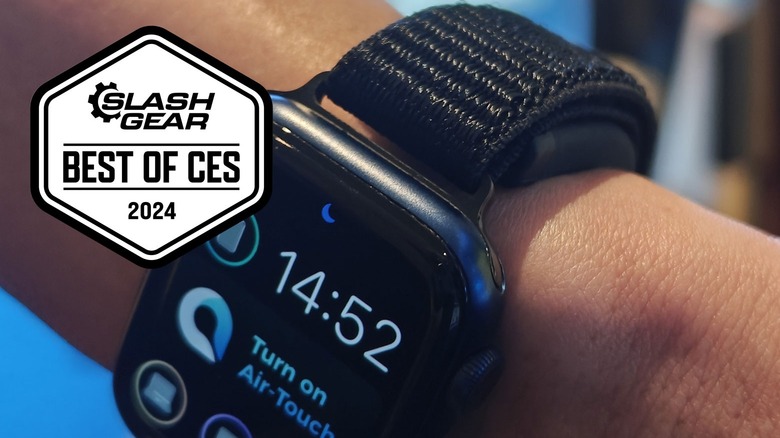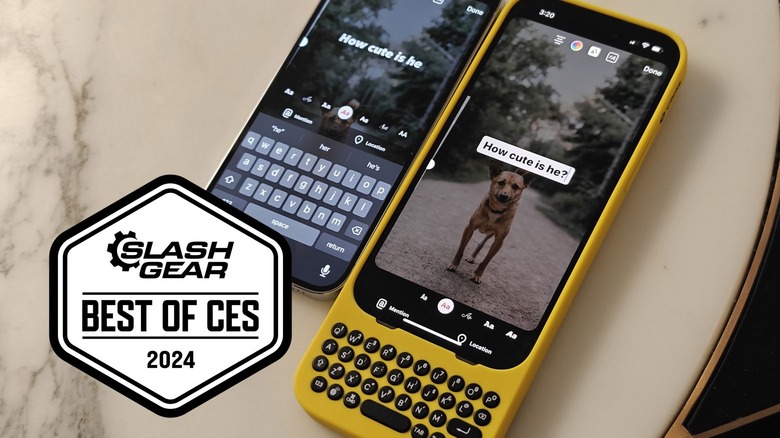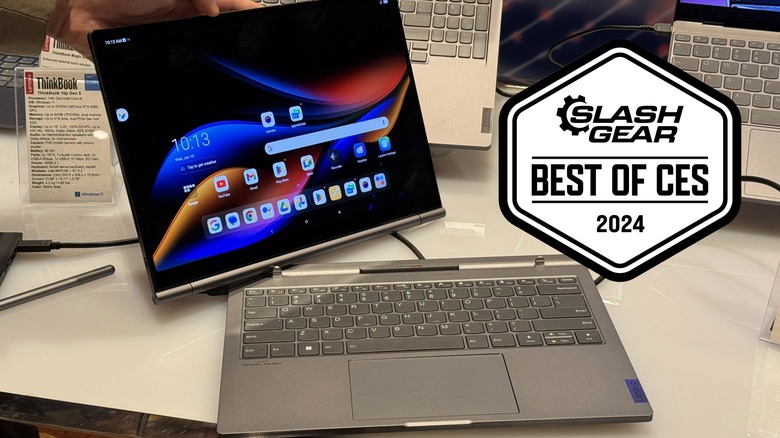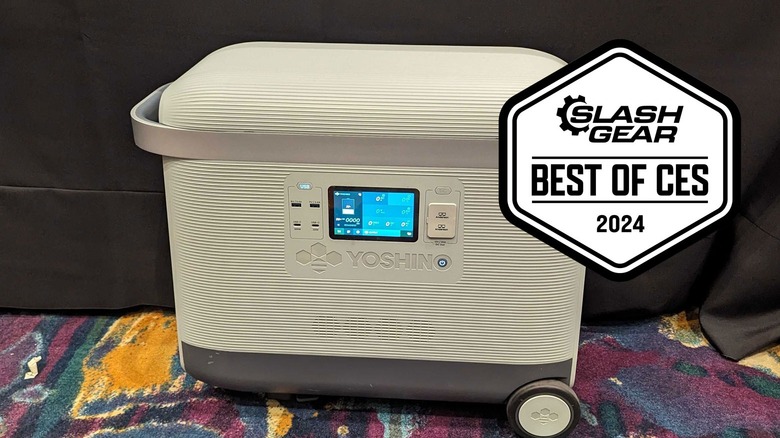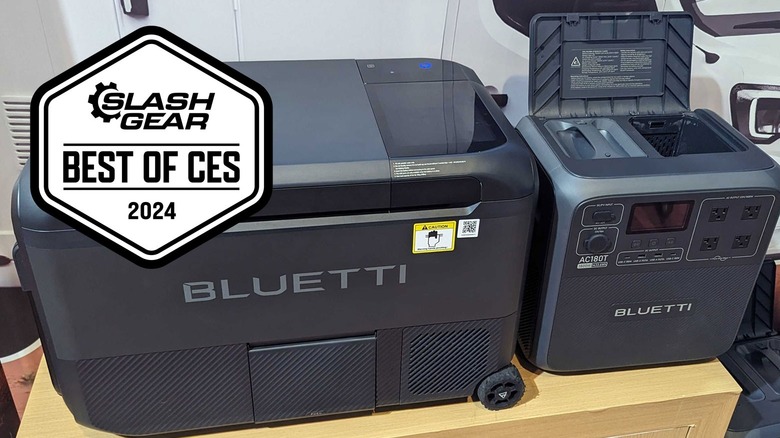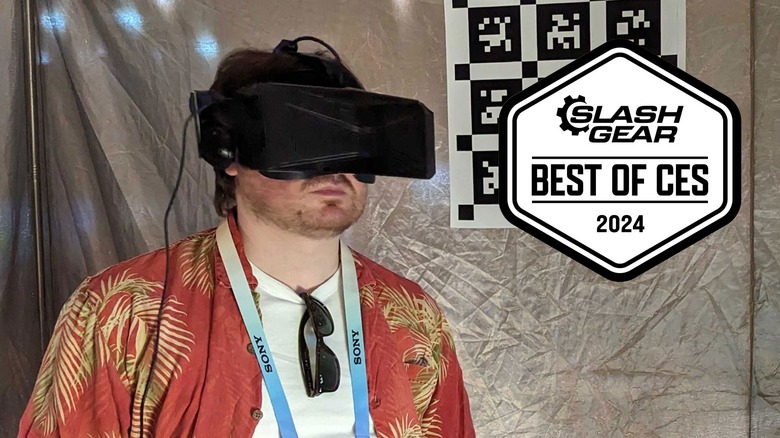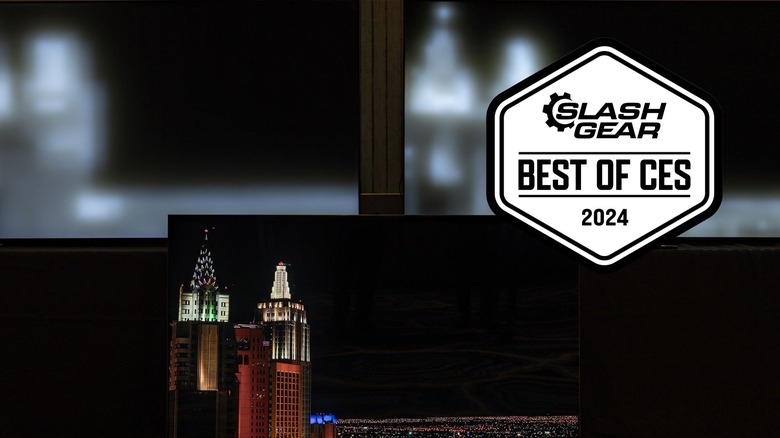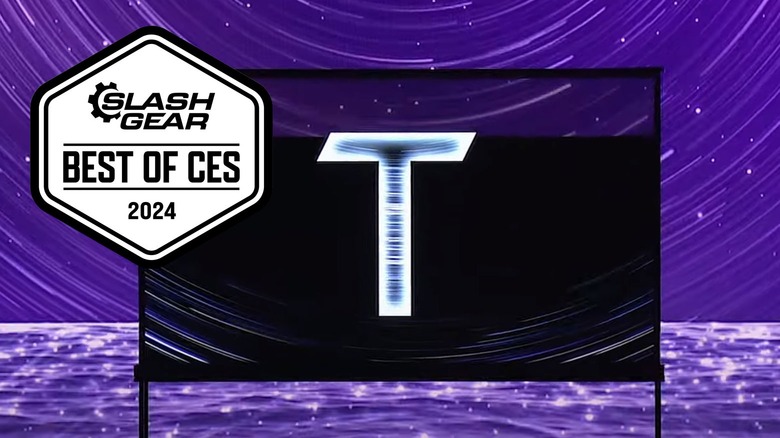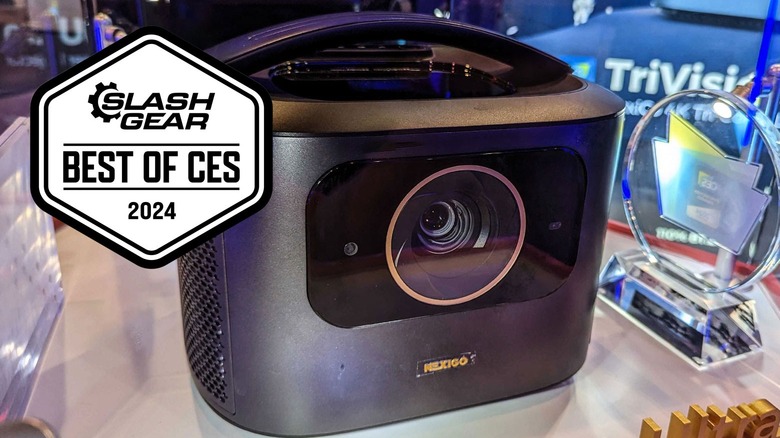SlashGear's Best Of CES 2024
It bills itself as the biggest technology show in the world, a melting pot of the latest and greatest in everything from TVs, wearables, and gadgets, through to automotive, autonomous driving, and bleeding-edge gaming. You'd be forgiven for feeling overwhelmed by CES 2024, then, and the thousands of new products and ambitious startups filling Las Vegas for a week.
Luckily, SlashGear was on the ground in the many, many halls, booths, and private demos, keeping track of everything that might be worth opening your wallet for later in 2024. Our Best Of CES 2024 awards aren't just about the shiniest tech or the very latest buzzwords. Instead, we're all about highlighting the announcements that look set to make a meaningful difference in your life.
Whether you're interested in home entertainment, fascinated by automotive technology, or looking to ride out a power outage or an outdoor excursion, we've got the stand-out launches from CES 2024 all wrapped up for you.
This article also includes contributions from Adam Doud and Dave McQuilling.
Best Automotive: Mercedes-Benz MBUX Sound Drive
Those familiar with will.i.am's track record in the tech industry would be forgiven for expecting the worst from Mercedes' MBUX Sound Drive, but the dynamically-generated EV soundtrack debuted at CES 2024 bucks the rapper-and-producer-turned-futurist's trend. Hooked into the underlying electronics of Mercedes-AMG's electric vehicles, MBUX Sound Drive uses speed, steering, and braking data — among other things — to weave music in real-time, unique to each trip.
It sounds like a gimmick, but time behind the wheel of a Mercedes electric car suggests otherwise. Mercedes and will.i.am's big plans for a song-swapping social hub of musicians and drivers may never come to pass, but rethinking what noise a car should make when it no longer has an internal combustion engine humming in the background is no bad thing. And, lest you assume this is just another flight of CES fancy, Mercedes says it'll be updating its EVs with MBUX Sound Drive later in the year.
Best Design: Kia PBV
The idea of a modular vehicle which can by turns be a delivery van, a people mover, a robotaxi, or a truck isn't new, but Kia's ambitious unveil at CES 2024 stands more chance than most to actually make it from drawing board to asphalt. The Kia PBV, or Purpose-Based Vehicle, debuts a new, shared electric platform that the automaker envisages underpinning a whole family of future EV fleets. Different bodies could attach, along with a whole ecosystem of accessories.
It means that the same core vehicle could be an urban delivery van by day, a taxi — or even a robotaxi, using technology from Hyundai Group-backed Motional — in the evening, and then a customizable RV for weekend adventures. As a strategy that's not entirely new, but it's Kia's scale that could see the PBV being the first of these modular electric platforms actually deploying in the real world.
Best Audio: Brane X
Every now and then you run across a device that is surprising. Sometimes it's a surprising feature or a surprising quirk you didn't expect. The Brane X smart speaker has a surprisingly full sound that you don't expect coming from a speaker of its size. The Brane X speaker has a built-in subwoofer, which isn't all that strange, but the depth of the bass that the speaker can achieve is remarkable.
A subwoofer is generally a larger part of a speaker, and that is certainly the case here. But Brane Audio has developed tech that shrinks the size of the subwoofer while keeping the same amount of volume of noise. The speaker itself is about the same size as a subwoofer you would get with a set of computer speakers, but those speakers usually come with a set of midrange and high-end speakers for your desktop. The Brane X has all of those components in one unit and a 12-hour battery besides.
You can connect to the Brane X with Bluetooth or a standard (headphones size) aux jack. Brane Audio envisions this speaker will live comfortably outside at your next pool party (IP57) or as the soundbar for your TV, and that's easy to believe. The sound is full and rich and blows you away considering the small package it comes in.
Best Laptop: ASUS Zenbook Duo
There was no shortage of laptops at CES, as is typically the case, but only one stood above the rest — literally and figuratively. The ASUS Zenbook Duo borrows a lot of DNA from last year's Best Laptop award winner, the Lenovo Yoga Book 9i, and then says "Hold my beer" and tops it in many ways. Not only does the Zenbook Duo add a ton of I/O to the side of the laptop (including an HDMI port), but it also corrects some of the hardware compromises Lenovo had to make.
The Zenbook Duo has a full-sized keyboard with a full trackpad besides. The keyboard itself sits in between the closed top and bottom of the laptop and charges at the same time. Plus, the keyboard can connect to the laptop with pogo pins, meaning the keyboard can work even when it hasn't been charged. The kickstand that you use to set the laptop up is also integrated into the laptop itself, rather than relying on a folio.
You can use the laptop in either a top/bottom orientation or side-by-side, each of which has its use cases. ASUS also has tricks for navigating the UI which we'll get into in our full review when it comes. For now, this is the most exciting laptop shown at CES and shows how quickly this space is maturing.
Best Gaming Hardware: MSI Claw
Like most other high-end handheld gaming systems, the MSI Claw runs a full version of Windows 11 Home or Pro, has an Intel Core Ultra 7 processor 155H, and a 7-inch FHD touchscreen with 120Hz refresh rate and 500 nits of brightness.
The battery size on the MSI Claw is impressive at 53Wr, considering its size, which sits somewhere in between the ASUS Ally and the Lenovo Legion Go. For reference, the Legion Go has a 50Wh battery. The handles on the MSI claw are not detachable. The backside of the Claw has two programmable macro buttons that allow you to record several movements and execute them with a push of a button. That can be handy when you're trying to cycle through a complicated set of movements in the middle of a game.
Overall, the handheld gaming market has exploded over the past year with entrants coming from Steam, Logitech, Lenovo, ASUS, and more. It's exciting to put the power of a PC, in a device small enough to stand and play, even when you're waiting in line or out on a drive. The MSI Claw is the latest of these and MSI has some good ideas here. It'll be fun to see how this space continues to grow.
Best Wearable: Mudra Band
Imagine swapping out your Apple Watch strap for a slightly thicker band, that also allows you to control any computing device completely hands-free. The Mudra band looks to do just that. The watch band is embedded with sensors that read electrical impulses from your brain to the muscles in your fingers. That allows you to select items on the screen using a cursor that you move around by moving your arm. When you need to select something, you pinch your fingers, and the band registers it with a click.
Mudra also developed an Apple Watch app that lets you switch seamlessly between devices. A quick tap on the watch gets you connected to a device, and a second tap switches you to a new one. You can also use the watch app to recent your cursor, or like a regular mouse, you can move your cursor to the side of the screen and adjust it that way. It's all very intuitive, and Mudra thinks this could get us closer to a "Minority Report" style of interface with your devices, for better or for worse.
Best Accessory: Clicks
Back in the day, phones had a physical keyboard you could use to type out emails and messages. Since then, phones have resorted to virtual keyboards that offer their own benefits to be sure, but if part of you is craving that old-school feel, Click has an answer for you. Clicks is a phone case/accessory keyboard hybrid that adds a set of physical keys to the bottom of your iPhone allowing to you tap out your messages, just like in the days of yore.
Clicks works with the iPhone 14 Pro initially and is coming to the iPhone 15 Pro and iPhone 15 Pro Max shortly due to Apple's changeover from Lightning connectors to USB Type-C. Indeed the phone slides into the case and plugs into a connector that takes care of the keyboard input and powers the backlight behind the Clicks' keys. There's no battery required for Clicks to work.
So the only question you have to answer for yourself is, "Do you miss those old keyboards?" and of course, "Do you have an iPhone 14 Pro, iPhone 15 Pro, or iPhone 15 Pro Max?" If the answer to both of those questions is yes, then you are in the particular niche that Clicks is targeting, and you can order your own soon.
Best Tablet: Lenovo ThinkBook Plus Gen 5 Hybrid
Lenovo is no stranger to bringing fun devices to CES, and this year's is one of the most fun yet. The Lenovo Thinkbook Plus Gen 5 Hybrid laptop is our pick for the best tablet at CES. You might be wondering how a laptop qualifies as a tablet. Like the original Microsoft Surface Book, the screen on this laptop detaches, but unlike that laptop from years ago, this laptop screen turns into a tablet running Android 13.
Each piece of the disassembled laptop has its own battery, processor, memory, and RAM. The keyboard half has an Intel Core Ultra 7 processor, 32GB of LPDDR5x RAM, and 1 TB of Storage while the screen has a Snapdragon 8+ Gen 1 processor, 12GB of RAM, and 256GB of storage on its own. What makes this even more unusual is that while the tablet is detached, the Windows portion of the computer still runs, meaning you can connect it to an external monitor to continue working on the laptop and use the Android tablet at the same time.
It's a device that fits that "carry just one device" niche that so many aspire to. You can work on something while traveling and when you're done, you can pop off the screen and switch to a movie you have saved to Netflix. It's weird, sure, but it's also pretty cool once you dive into the various use cases it offers.
Best Smart Home/IoT: Yoshino Power Solid State Battery
A lot of smart home and battery tech was on display at CES, but only one company seemed to offer us a true glimpse of the future. Yoshino already has a few solid-state batteries on the market and used the event to showcase its upcoming B6000 SST portable power station.
Solid-state batteries are undoubtedly the way forward, and most major companies are conducting intense research into the concept. Over the next few years, we'll see them crop up in everything from cell phones to cars, but for now, you can only get solid-state batteries in Yoshino's products.
The main benefit is increased energy density, so you'll get around twice the amount of power storage for around the same weight when comparing a solid-state device to something like a lithium-ion cell. Then there's the safety aspect, solid-state power isn't capable of bursting into flames like some current products on the market. It's also infinitely linkable, so if you have the money to buy a bunch of these you could store as much power as you want. The only downside is price, with the power stations currently coming at a 30% premium — which isn't too bad for cutting-edge tech.
Best Outdoors: Bluetti Modular Battery
Bluetti used CES as a platform to showcase its SwapSolar ecosystem. The most interesting thing about this system is the AC180T's pair of modular batteries. You plug the batteries into the AC180T power station where they can charge and discharge based on your needs — essentially making it function as a regular portable power station. However, the fun does not stop there.
The modular batteries can be removed and used to power other things like the portable "Multicooler" fridge/freezer Bluetti also debuted at CES 2024. These modular batteries have a few key benefits. First, they're lighter than a full power station and thus more portable. Secondly, one can be charging while the other is powering something important, which theoretically allows constant power to be applied.
It's early days, so it's impossible to say what applications the cells will have beyond the Multicooler. However, if it's possible to buy more cells, they're relatively cheap to purchase, and there's eventually a wide range of devices that can use them, then this could be a truly great innovation in the world of portable power. For now, the cooler/battery combo is a great way to make an outdoor adventure more comfortable.
Best VR: Wireless Pimax Crystal
Pimax has been operating at the high end of the consumer VR landscape for several years, offering industry-leading clarity and an extremely wide field of view. Other high-end features like eye tracking and arguably the highest resolution displays in consumer VR have also made its headsets stand out. But some lower-end headsets have always had one major technical advantage over Pimax's efforts. The Meta Quest and its successors allowed for completely wireless play, both standalone and on PC.
That gap may soon close as Pimax aims at releasing a wireless version of its Crystal headset. The wirelessness comes courtesy of a 60G AirLink connection, which turns the Crystal into the "world's first ultra-high-definition VR headset with wireless connectivity." We tried it out, and while it's apparent the wireless headset is still in the prototyping phase, it shows a lot of promise. A particular highlight is its weight distribution, which means Pimax's upcoming release is a lot more comfortable than it looks.
Best TV: Sony Mini LED prototype
A promising prototype has snatched our Best TV at CES award. The backlight on a prototype the Japanese manufacturer was displaying at CES is around 150% brighter and has over 300% more zones compared to the X95L. This allows for a highly detailed and controllable backlight, which greatly enhances overall picture quality and contrast.
Sony's prototype backlight technology is one of those things that you have to see to believe. When the LED panels are stripped back, and the backlight is exposed, you can still make out details like faces, or individual objects, on the screen. This hits home harder when it is compared with a competitor's TV in a similar situation. The equivalent Samsung TV was using vaguely lit areas and was nowhere near as sharp as its Japanese rivals. Sony puts this down to its new LED driver, which is roughly the size of a sesame seed.
"The newly designed LED driver allows around a 300% increase compared to the X95L," said a Sony representative speaking with SlashGear. "The larger point is that the smaller driver allows for the same level of control (22-bit) with triple the density, whereas competitors add zones at the expense of zone control. This is why the blue backlight demo was so bland on the competitor model, further showing that zone control trumps zone density."
Best Display Technology: LG Signature OLED T
Arguably the most mindblowing unveiling of CES came courtesy of LG and its transparent OLED technology. The South Korean manufacturer's booth often courts attention with outlandish displays, and its wall of see-through televisions certainly did the job this year. Seeing highly detailed pictures form and move on a crystal-clear background may be somewhat of a novelty, but it will take a while to wear off.
This isn't just a case of a clear screen when not in use, a black screen when it's showtime either. LG's transparent OLED has two modes, one that will let you view things while maintaining a clear background and another that will raise a black screen for those times when you need a more traditional TV viewing experience. As far as case uses go, it's designed for people who want a large TV, without sacrificing their view of a decorated wall or scenic window. Those people also presumably have lots of money, as while pricing isn't confirmed these are unlikely to come cheap.
Best Projector: Trivision Ultra
There are a lot of high-end projectors at CES, and truth be told a lot of their features and specs are very similar or a touch pointless. Throw distance makes anything over 150 inches pretty much unachievable on standard throw models, things like true blacks are mostly due to the screen, not the projector itself, and while a few 8K models are on display you have to question the point of it all. Our pick for the best projector is "only" 4K, but it aims to solve an issue that has plagued high-end projectors for a while.
Laser projectors are prone to "speckling" which can ruin image quality and affect position measurements. NexiGo believes it has tackled this problem with the "Industrial ALPD 5.0" technology inside of its upcoming Trivision Ultra projector. The projector uses a combination of tri-LED and tri-laser light sources to produce the image, and as speckling only manifests with laser projectors we'd imagine the LED supplement is what fixes the issue. Either way, it's something that made the Trivision Ultra stand out in what was a strong field of projectors this year.
